Ship-Based Carbon Capture and Storage: A Supply Chain Feasibility Study
Abstract
:1. Introduction
2. Materials and Methods
2.1. Research Framework
- Requirements analysis: A systems engineering project usually starts with a translation of the customer needs statement into a set of requirements. These requirements are the basis for any design. They will also be used to evaluate the design(s). The requirements were derived from scientific and technical literature and many discussions with the ship owner/user and external experts.
- Concept exploration (modeling): In this stage a model was developed that allows estimation of the emission reduction potential and (economic) impact of each concept on board the offshore vessel. Next, operations scenarios were built to estimate the volume of CO2 to be captured and stored. The way the vessel is deployed, the space needed and location of the technical systems are also important factors to determine if a concept is compatible with regular operations on board the vessel. This also affects how the transport to an onshore user would best be carried out.
- Concept definition (case study): The most interesting concepts were analyzed in more detail to derive the key factors that are likely to affect the overall feasibility of the proposed carbon capture and supply chain concept. This part includes a first validation of the final concept(s). However, it is not a fully feasibile study because this would have meant that all elements of the concept(s) would have been tested at a realistic scale.
2.2. Requirements Analysis
- Technology: What are the requirements for and elements of a fully functioning CO2 capture and logistic concept for this vessel type? How much CO2 could be captured?
- Emissions: Is the emission of CO2 during transport lower than the amount captured? Are the IMO2030 and IMO2050 emission reduction targets feasible?
- Economics: What is the investment cost and payback time of the capture technology? What would be the impact of a CO2 tax?
- Operations: What is an acceptable impact of the concept on vessel availability and regular operations? Can carbon capture be executed in conjunction with operations and activities, or does it require temporary stopping of work?
2.3. Technical Concept
2.3.1. Carbon Capture
2.3.2. On Board Storage
2.3.3. Transportation
2.3.4. Utilization–End-Of-Life
2.4. Emissions
- Emission minimization: The goal is to capture as much CO2 as is technically and operationally feasible. The CO2 emission during the transport of LCO2 must not neutralize the emission avoided by capturing.
2.5. Economics
- CO2 tax: There is a tax on the emission of CO2 for some polluting industries in some countries [26]. Shipping has so far been excluded from initiatives such as the Paris Agreement [5], but has been on the table at COP26 [27]. In a scenario where a tax is levied on every tonne of CO2 a vessel emits, capturing this CO2 may have financial benefits for a vessel owner, as it saves on taxes payable.
- Emission permits: Shipping could also become part of an emission trading system, like the European Emission Trading System (ETS). The captured CO2 could then be traded and priced properly.
- Utilization revenue: A good example of a system where the costs of carbon capture can pay for itself is the OCAP (Organic CO2 for Assimilation by Plants) network in Rotterdam [22]. CO2 is captured from industrial processes in the port area and transported via pipelines to greenhouses in the Westland over a distance of ±30 km. Here the CO2 is sold for €50 to €100 per tonne to greenhouse owners, who use it to enrich plant growth.
2.6. Operations
3. Scenarios and Modeling
3.1. Model Scope
3.2. Data and Assumptions
3.3. Model Verification and Validation
3.4. Case Study
3.4.1. Base Scenario
3.4.2. Scenario Sets
4. Case Study Results
4.1. Base Scenario Results
4.2. First Iteration
4.3. Second Iteration
4.4. Detailed Design
- Capture Phase: The ship owner has invested €16.5 M in the carbon capture installation, and can capture the CO2 at a cost of €75 per tonne of CO2. The ship has hybrid storage on board with built-in fixed tanks with a size of 1100 m3. The vessel has space to store 50 tank containers (22 m3 each). The payback period under the above conditions is shown in Table 4. A more detailed time planning could optimize CO2 pickup moments and reduce distance covered, hence cost.
| Payback Time (Years) | Taxation (€/tonne CO2) | |||
|---|---|---|---|---|
| Utilization (€/tonne CO2) | 75 | 100 | 150 | |
| 75 | 13 years | 8 years | 5 years | |
| 100 | 8 years | 6 years | 4 years | |
| 150 | 4 years | 4 years | 3 years | |
- Transportation Phase: The CO2 is transported with liquid gas carriers and offshore supply vessels, which come along once every 29 days to offload. The CO2 is distributed via the OCAP pipeline [22]. The average length of this transport pipeline is 50 km.
- Utilization phase: The pipeline ends in the horticultural greenhouses in the Westland area (north-west of Rotterdam) to promote plant growth. The CO2 is sold here, for which the ship owner can receive €75–€ 150 per tonne of CO2.
4.4.1. Strategic Considerations
- Does the ship comply with the IMO2030/IMO2050 targets if carbon capture is used?
- What are the technical implications for the ship, i.e., how much space is there on board the ship for capture and storage facilities?
- To what extent does the capture and storage effect the operational activities for which the vessel was designed and is this acceptable?
- What is willingness to pay to capture the CO2 on board and is that enough to pay for the capture and storage?
- What is the average distance at which the ship can operate offshore? Any doubling in distance can increase payback time by 25% to 60%. Emissions from the supply chain are also affected by distance, although the effect of costs on feasibility is greater. A liquid gas carrier can sail almost 9000 km with 1100 m3 on board before emitting as much as it transports [14].
- What is an acceptable payback period?
- How to use external conditions to reduce the payback period? A carbon tax combined with the sales of CO2 can generate income at price levels of €75–€100 per tonne of CO2, which may make the payback period acceptable.
4.4.2. Evaluation
5. Results and Conclusions
5.1. Technology
5.2. Emissions
5.3. Economics
6. Discussion and Further Research
- A study into the disruptive nature in the CO2 market of ship-based carbon capture. As the adoption of the technology increases in popularity among ship owners, more CO2 will be marketed, which in turn entails the risk of market saturation.
- A study into the scope of a CO2 tax. Will this only target pure CO2 emissions, or also CO2 equivalent emissions? If GWP becomes relevant, then the issue of methane slip in LNG engines should be considered, as it will negatively affect the capture potential. It could also mean that engine conversion from HFO to LNG is not a viable route anymore.
- A study into the effect of subsidies to stimulate this technology. With subsidies the cost of capital and the payback period could be reduced substantially. What would be the optimal subsidy level? Should it be a temporary subsidy?
- If the cost of capture would decrease to such a level that it could become economically beneficial for a ship owner to produce and sell more CO2, there is a risk of overshooting and more fossil fuels will be burned. Should this be prevented and if so, how?
- Transport of CO2 is expensive. What are the options to use it on the vessel, for example to produce synthetic fuels onboard? This would render the whole supply chain issue obsolete.
- Ships operate on a global scale. This study mainly looked at European conditions. For a complete life cycle analysis, the opportunities in other places in the world must be examined in more detail.
Author Contributions
Funding
Institutional Review Board Statement
Informed Consent Statement
Data Availability Statement
Conflicts of Interest
Appendix A
| Parameter | Value | Unit | Source/ Footnote | Comment |
|---|---|---|---|---|
| Capture Cost of capture | 100 | €/tonne CO2 | [15] | Assumed value, based on estimations by TNO/ASPEN+ |
| Transportation offshore Container daily lease price | 4.93 | €/day | 1 | |
| Offshore supply vessel charter rate | 21411.5 | €/day | 2 | |
| Offshore supply vessel trip dependent cost | 0.01314 | €/tonne km | [28] | |
| Liquid gas carrier transport price | 0.019 | €/tonne km | [29] | |
| Transportation onshore prices Road | 0.07 | €/tonne km | 3 | |
| Rail | 0.267 | €/tonne (100 km) | 4 | |
| Pipeline | 0.00929 | €/tonne km | 5 | |
| Inland barge | 0.03429 | €/tonne km | 6, 7 | |
| Utilization costs onshore sequestration low | 6.195 | €/tonne CO2 | [20] | |
| Onshore sequestration high | 11.504 | €/tonne CO2 | [20] | |
| Offshore sequestration low | 7.965 | €/tonne CO2 | [20] | |
| Offshore sequestration high | 17.699 | €/tonne CO2 | [20] | |
| Sequestration profit EOR sales low | 13.274 | €/tonne CO2 | [20] | |
| Sequestration profit EOR sales high | 35.398 | €/tonne CO2 | [20] | |
| Horticulture sales price | 50.00 | €/tonne CO2 | 8 | and interviews |
| Utilization sales assumed | 50.00 | €/tonne CO2 | [30] |
| Parameter | Value | Unit | Source/ Footnote | Comment |
|---|---|---|---|---|
| Emissions base case | ||||
| Work | 95 | tonne CO2/day | Heerema | Rounded value |
| Transit | 130 | tonne CO2/day | Heerema | Rounded value |
| Daily LCO2 production with 82% capture rate and 102% LNG usage | ||||
| Work | 80 | tonne/day | Calculated | |
| Transit | 110 | tonne/day | Calculated | |
| Transportation offshore | ||||
| Liquid gas carrier | 8.633 × 10−6 | tonne/tonne km CO2 | [13] | |
| Offshore supply vessel | 0.1385 | tonne/km | 9 | Amount of CO2 left outside of this equation (i.e., same for 1 tonne or 100 tonnes) |
| On board own vessel | 130 | tonne/day | Heerema | |
| Onshore transportation | ||||
| Road | 1.032 × 10−6 | tonne/tonne km CO2 | 10 | |
| Rail | 3.5 × 10−6 | tonne/tonne km CO2 | [31] | |
| Inland barge | 3.5 × 10−6 | tonne/tonne km CO2 | [31] | |
| Pipeline | No CO2 emissions in ideal situation | |||
| Utilization emissions | ||||
| Materials vector | No CO2 emissions in ideal situation | |||
| Direct utilization | Depending on the input value chosen (0–100%) | |||
| Horticulture | No CO2 emissions in ideal situation | |||
| Sequestration | No CO2 emissions in ideal situation |
Appendix B
| Scenario Set | Scenario Subset | Description | Default Parameters | Variation |
|---|---|---|---|---|
| 1 | Hybrid (50/50) OSV/LCG Offshore distance 100 km Onshore distance 50 km pipeline Cost of Capture €100 | |||
| 1.1 | Sailing, small storage | 1100 m3 storage 11 days offloading interval | ||
| 1.2 | Sailing, large storage | 2200 m3 storage 22 days offloading interval | ||
| 1.3 | Working, large storage | 2200 m3 storage 29 days offloading interval | ||
| 2 | Hybrid (50/50) OSV/LCG Onshore distance 50 km pipeline Cost of Capture €100 | Offshore distance 200 km | ||
| 2.1 | Sailing, small storage | 1100 m3 storage 11 days offloading interval | ||
| 2.2 | Sailing, large storage | 2200 m3 storage 22 days offloading interval | ||
| 2.3 | Working, large storage | 2200 m3 storage 29 days offloading interval | ||
| 3 | Hybrid (50/50) OSV/LCG Offshore distance 100 km Cost of Capture €100 | Onshore distance 100 km pipeline | ||
| 3.1 | Sailing, small storage | 1100 m3 storage 11 days offloading interval | ||
| 3.2 | Sailing, large storage | 2200 m3 storage 22 days offloading interval | ||
| 3.3 | Working, large storage | 2200 m3 storage 29 days offloading interval | ||
| 4 | Hybrid (50/50) OSV/LCG Offshore distance 100 km Onshore distance 50 km pipeline | Cost of Capture €75 | ||
| 4.1 | Sailing, small storage | 1100 m3 storage 11 days offloading interval | ||
| 4.2 | Sailing, large storage | 2200 m3 storage 22 days offloading interval | ||
| 4.3 | Working, large storage | 2200 m3 storage 29 days offloading interval | ||
| 5 | Hybrid (50/50) OSV/LCG Onshore distance 50 km pipeline | Cost of Capture €75 Offshore distance 100 km | ||
| 5.1 | Sailing, small storage | 1100 m3 storage 11 days offloading interval | ||
| 5.2 | Sailing, large storage | 2200 m3 storage 22 days offloading interval | ||
| 5.3 | Working, large storage | 2200 m3 storage 29 days offloading interval | ||
| 6 | Hybrid (50/50) OSV/LCG Offshore distance 100 km | Cost of Capture €75 Onshore distance 50 km | ||
| 6.1 | Sailing, small storage | 1100 m3 storage 11 days offloading interval | ||
| 6.2 | Sailing, large storage | 2200 m3 storage 22 days offloading interval | ||
| 6.3 | Working, large storage | 2200 m3 storage 29 days offloading interval |
| Scenario | Description | Default Parameters | Variation |
|---|---|---|---|
| 7 | Engine emissions −25% | Hybrid (50/50) OSV/LCG Offshore distance 100 km Onshore distance 50 km pipeline COC €75 2200 m3 storage CAPEX €16.5 M | Emissions factor 0.75 40 days offloading interval |
| 8 | No onshore transportation | Offshore distance 100 km COC €75 2200 m3 storage 29 days offloading interval Emissions factor 1 CAPEX €16.5 M | 0 km onshore Liquid gas carrier 100% |
| 9 | CAPEX −25% | Hybrid (50/50) OSV/LCG Offshore distance 100 km Onshore distance 50 km pipeline COC €75 2200 m3 storage 29 days offloading interval Emissions factor 1 | CAPEX €12.35 M |
References
- European Commission. Quantification of Emissions from Ships Associated with Ship Movements between Ports in the European Community. 2002. Available online: https://ec.europa.eu/environment/air/pdf/chapter2_ship_emissions.pdf (accessed on 29 October 2020).
- Lee, H.; Aydin, N.; Choi, Y.; Lekhavat, S.; Irani, Z. A decision support system for vessel speed decision in maritime logistics using weather archive big data. Comput. Oper. Res. 2018, 98, 330–342. [Google Scholar] [CrossRef]
- IMO. Third IMO Greenhouse Gas Study 2014. 2015. Available online: https://wwwcdn.imo.org/localresources/en/OurWork/Environment/Documents/Third%20Greenhouse%20Gas%20Study/GHG3%20Executive%20Summary%20and%20Report.pdf (accessed on 14 April 2021).
- IMO. Initial IMO Strategy on Reduction of GHG Emissions from Ships. 2018. Available online: https://www.imo.org/en/MediaCentre/HotTopics/Pages/Reducing-greenhouse-gas-emissionsfrom-ships.aspx (accessed on 14 April 2021).
- van der Minkelis, N. Letter from KVNR to Ship Owners on Impact of Announced ETS for Shipping; Koninklijke Vereniging van Nederlandse Reders, KVNR, Dept. of Technical and Environmental Affairs: Rotterdam, The Netherlands, 2020. [Google Scholar]
- AVR. First Tons of CO2 Captured from Residual Waste Supplied to Greenhouse Horticulture. 2019. Available online: https://www.avr.nl/en/press/first-tonnes-of-co2-captured-from-residualwaste-supplied-to-greenhouse-horticulture (accessed on 29 October 2020).
- Clayton, R. LNG Will Be Transitional Fuel for 2030, Nor-Shipping Hears. 2019. Available online: https://lloydslist.maritimeintelligence.informa.com/LL1127750/LNGwill-be-transitional-fuel-for-2030-NorShipping-hears (accessed on 29 October 2020).
- Upstreamonline.com. LNG Remains a Dead End for Decarbonizing Maritime Transport. 2019. Available online: https://www.transportenvironment.org/newsroom/blog/lng-remainsdeadend-decarbonising-maritime-transport (accessed on 29 October 2020).
- PaBalcombe, U.; Brierley, J.; Lewis, C.; Skatvedt, L.; Speirs, J.; Hawkes, A.; Staffell, I. How to decarbonize international shipping: Options for fuels, technologies and policies. Energy Convers. Manag. 2019, 182, 72–88. [Google Scholar] [CrossRef]
- Van den Akker, J. Carbon Capture Onboard LNG-Fueled Vessels. Ph.D. Thesis, Delft University of Technology, Delft, The Netherlands, 2017. [Google Scholar]
- Christiaanse, C. Offshore Transport, Conditioning and Storage of Carbon Dioxide. TU Delft Repository, Delft, 2018. Available online: https://repository.tudelft.nl/islandora/object/uuid%3A32548387-8048-497c-bf36-c6cd2ede4718 (accessed on 29 October 2020).
- Feenstra, M.; Monteiro, J.; van den Akker, J.T.; Abu-Zahra, M.R.; Gilling, E.; Goetheer, E. Ship-based carbon capture onboard of diesel or LNG-fuelled ships. Int. J. Greenh. Gas Control. 2019, 85, 1–10. [Google Scholar] [CrossRef]
- Aspelund, A.; Tveit, S.P.; Gundersen, T. A liquefied energy chain for transport and utilization of natural gas for power production with CO2 capture and storage—Part 3: The combined carrier and onshore storage. Appl. Energy 2009, 86, 805–814. [Google Scholar] [CrossRef]
- TEBODIN. CO2 Liquid Logistics Shipping Concept (LLSC) Overall Supply Chain Optimization; Knowledge Sharing Report; TEBODIN: The Hague, The Netherlands, 2011. [Google Scholar]
- Monteiro, J. Co2asts—Carbon Capture, Storage and Transfer in Shipping; Co2ASTS Public Concise Report; EU Interreg V A programme: Strassbourg, France, 2020. [Google Scholar]
- Kossiakoff, A.; Sweet, W.; Seymour, S.; Biemer, S. Systems Engineering Principles and Practice, 2nd ed.; John Wiley & Sons Inc.: Hoboken, NJ, USA, 2011. [Google Scholar]
- Sanchez, R. Technology Readiness Assessment Guide doe g 413.3-4a; US Department of Energy: Washington, DC, USA, 2011. [Google Scholar]
- Bassano, C.; Deiana, P.; Vilardi, G.; Verdone, N. Modelling and economic evaluation of carbon capture and storage technologies integrated into synthetic natural gas and power-to-gas plants. Appl. Energy 2020, 263, 114590. [Google Scholar] [CrossRef]
- Cuellar-Franca, R.M.; Azapagic, A. Carbon capture, storage and utilization technologies: A critical analysis and comparison of their life cycle environmental aspects. J. CO2 Util. 2015, 9, 82–102. [Google Scholar] [CrossRef]
- Rubin, E.S.; Davidson, J.E.; Herzog, H.J. The cost of CO2 capture and storage. Int. J. Greenh. Gas Control. 2015, 40, 378–400. [Google Scholar] [CrossRef]
- Ros, J.; Doedee, V.; Van den Akker, J.; Vredeveldt, A.; Linders, M.; Goetheer, E.; Monteiro, J. Update on post-combustion carbon capture and storage on LNG fueled vessels. In Proceedings of the 15th Greenhouse Gas Control Technologies Conference, Cheltenham, UK, 15–18 March 2021. [Google Scholar]
- OCAP. Over OCAP. 2020. Available online: https://www.ocap.nl/nl/overocap/index.html (accessed on 29 October 2020).
- Olfe-Krautlein, B.; Naims, H.; Bruhn, T.; Lorente Lafuente, A.; Tobias, M. CO2 as an Asset? 2014. Available online: http://publications.iass-potsdam.de/pubman/item/escidoc:620894:4/component/escidoc:844891/IASS_Fact_Sheet_2014_2_en.pdf (accessed on 18 February 2020).
- Equinor. Northern Lights ccs. 2020. Available online: https://northernlightsccs.com/en (accessed on 29 October 2020).
- GrandView Research. Carbon Dioxide Market Size, Share & Trends Analysis Report. 2020. Available online: https://www.grandviewresearch.com/industry-analysis/carbondioxide-market (accessed on 18 February 2020).
- Asen, E. Carbon Taxes in Europe. 2019. Available online: https://taxfoundation.org/carbon-taxes-in-europe-2019/ (accessed on 29 October 2020).
- Timmermans, F. Speech by Frans Timmermans at COP26 Carbon Pricing in the European Union: An Invitation to the World. 2021. Available online: https://www.edf.org/media/cop26-ends-strong-result-carbon-markets-and-international-call-action-most-urgent-climate (accessed on 5 November 2021).
- Dosen, H.C.; Langeland, J. Offshore Freight Rate Determinants. Master’s Thesis, Norwegian School of Economics, Bergen, Norway, 2015. Available online: https://openaccess.nhh.no/nhh-xmlui/bitstream/handle/11250/300120/MasterThesis.PDF?sequence=1&isAllowed=y (accessed on 29 October 2020).
- Kler, R.D.; Neele, F.; Nienoord, M.; Brownsort, P.; Koorneef, J.; Belfroid, S.; Peters, L.; Wijhe, A.V.; Loeve, D. Transportation and Unloading of CO2 by Ship—A Comparative Assessment; WP9FinalreportCO2Shipping, CATO2 programme; TNO: Utrecht, The Netherlands, 2016. [Google Scholar]
- Lloyds Register & UMAS. Zero Emission Vessels 2030. How Do We Get There? Low Carbon Pathways 2050 Series, London. 2017. Available online: https://www.lrs.or.jp/news/pdf/LR_Zero_Emission_Vessels_2030.pdf (accessed on 5 November 2021).
- McKinnon, A. CO2 Emissions from Freight Transport in the UK; Commission for Integrated Transport: London, UK, 2007. [Google Scholar]
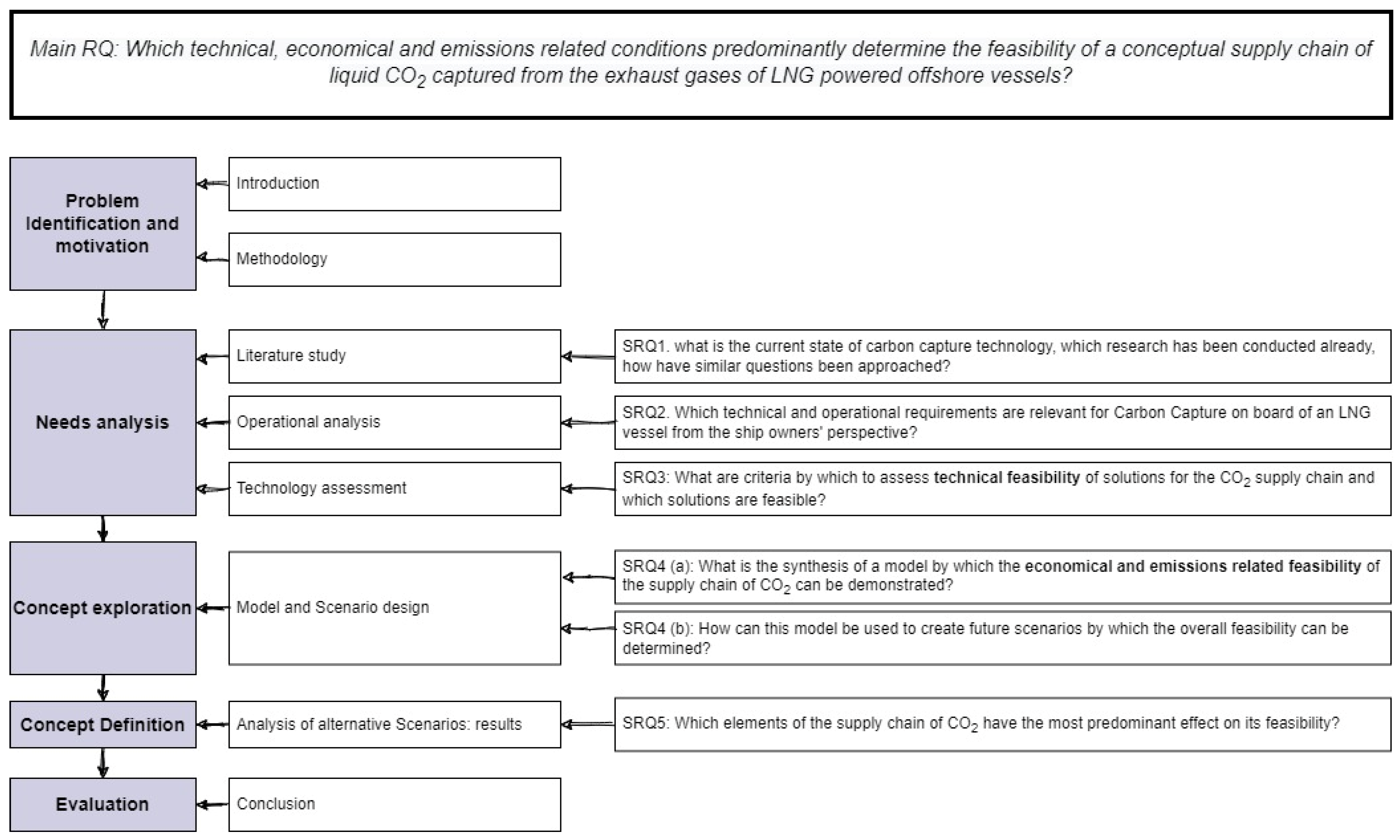
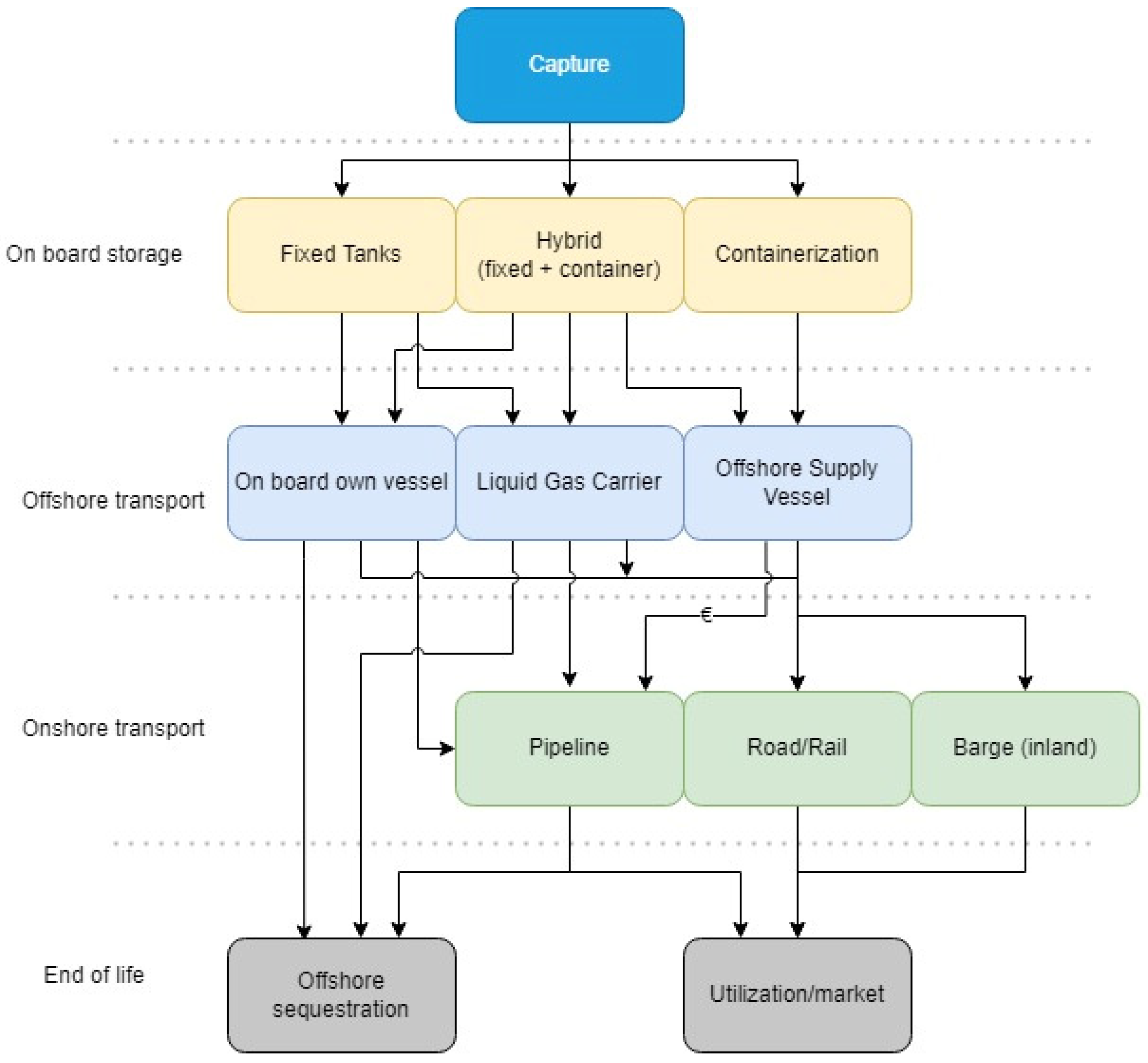
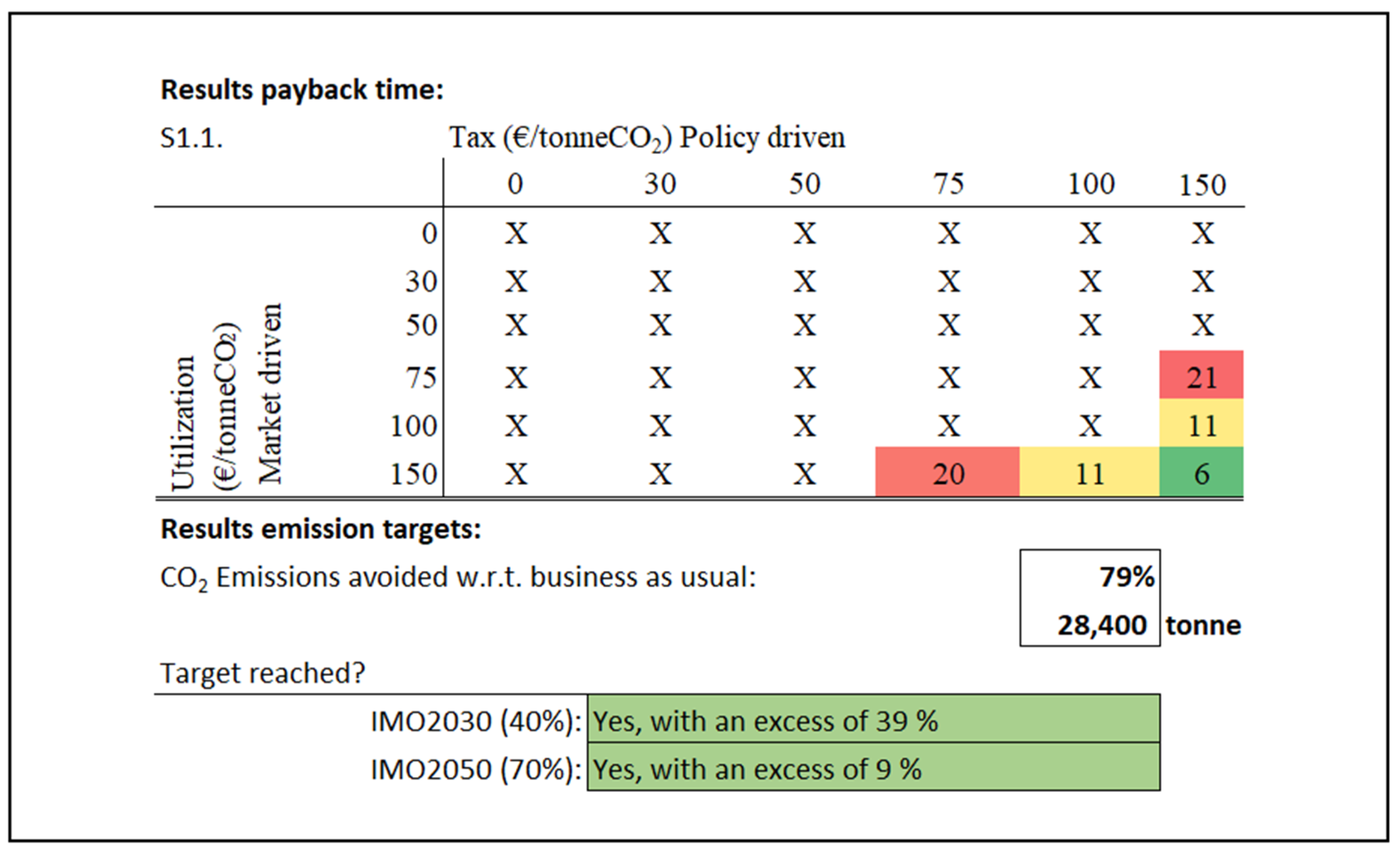
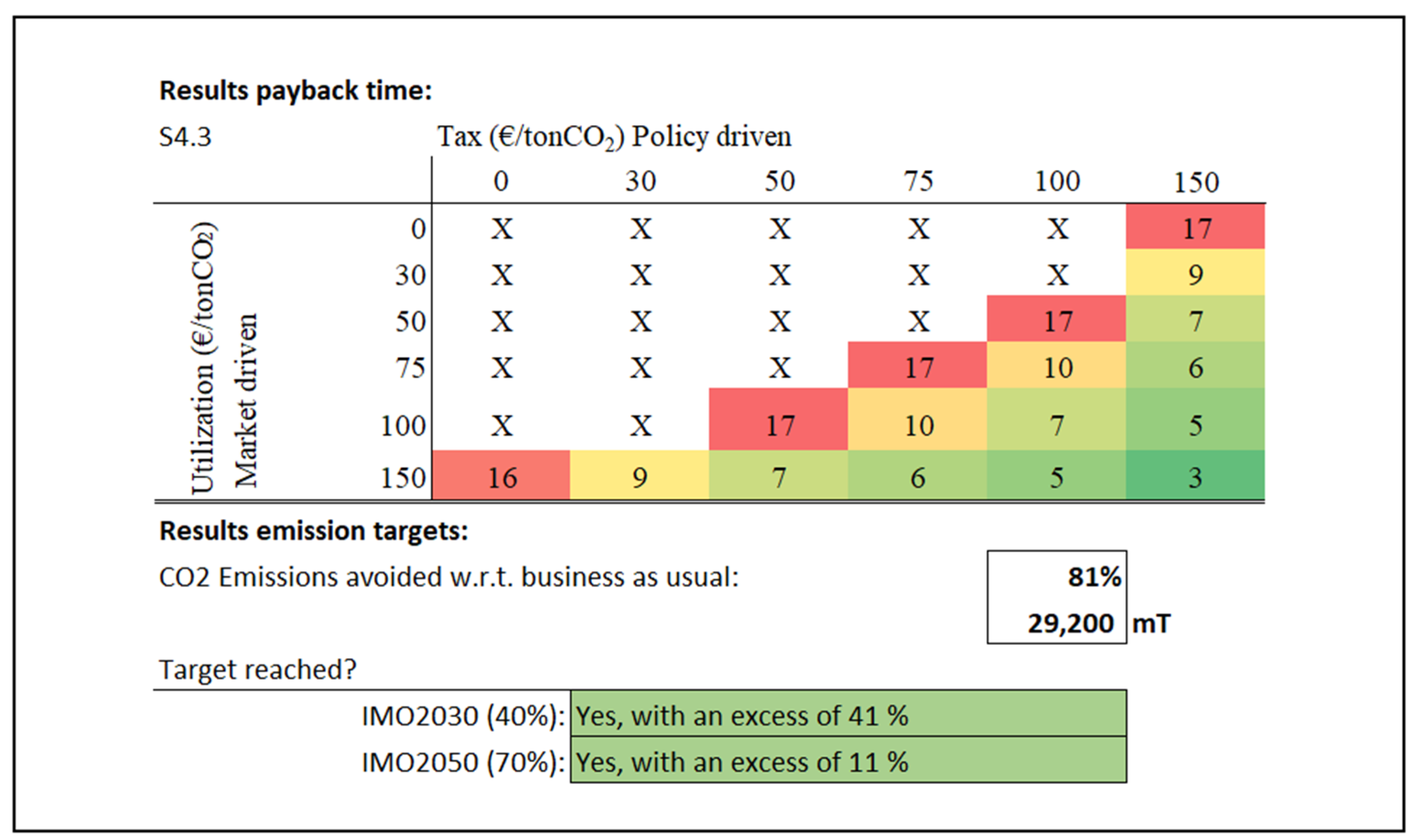
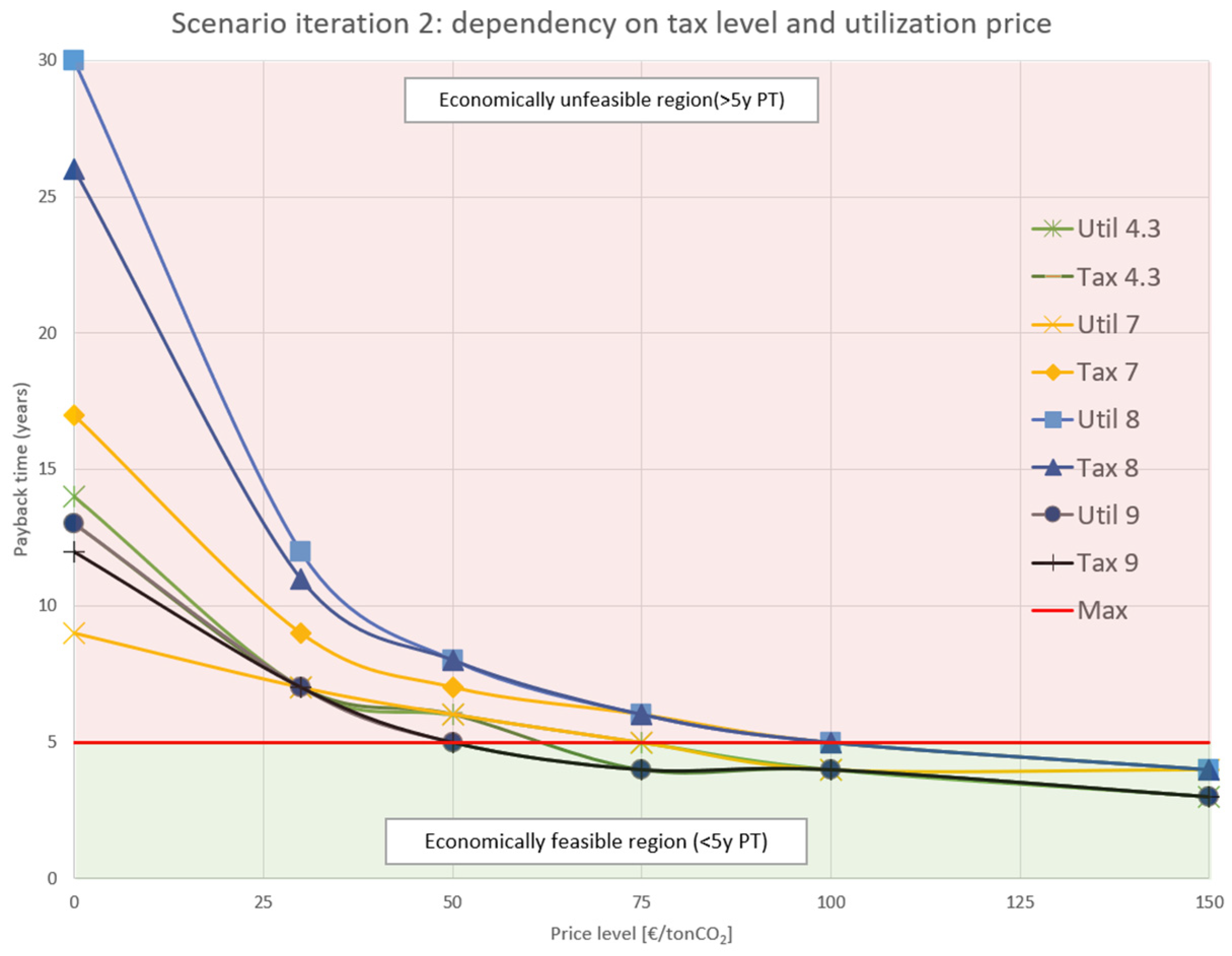
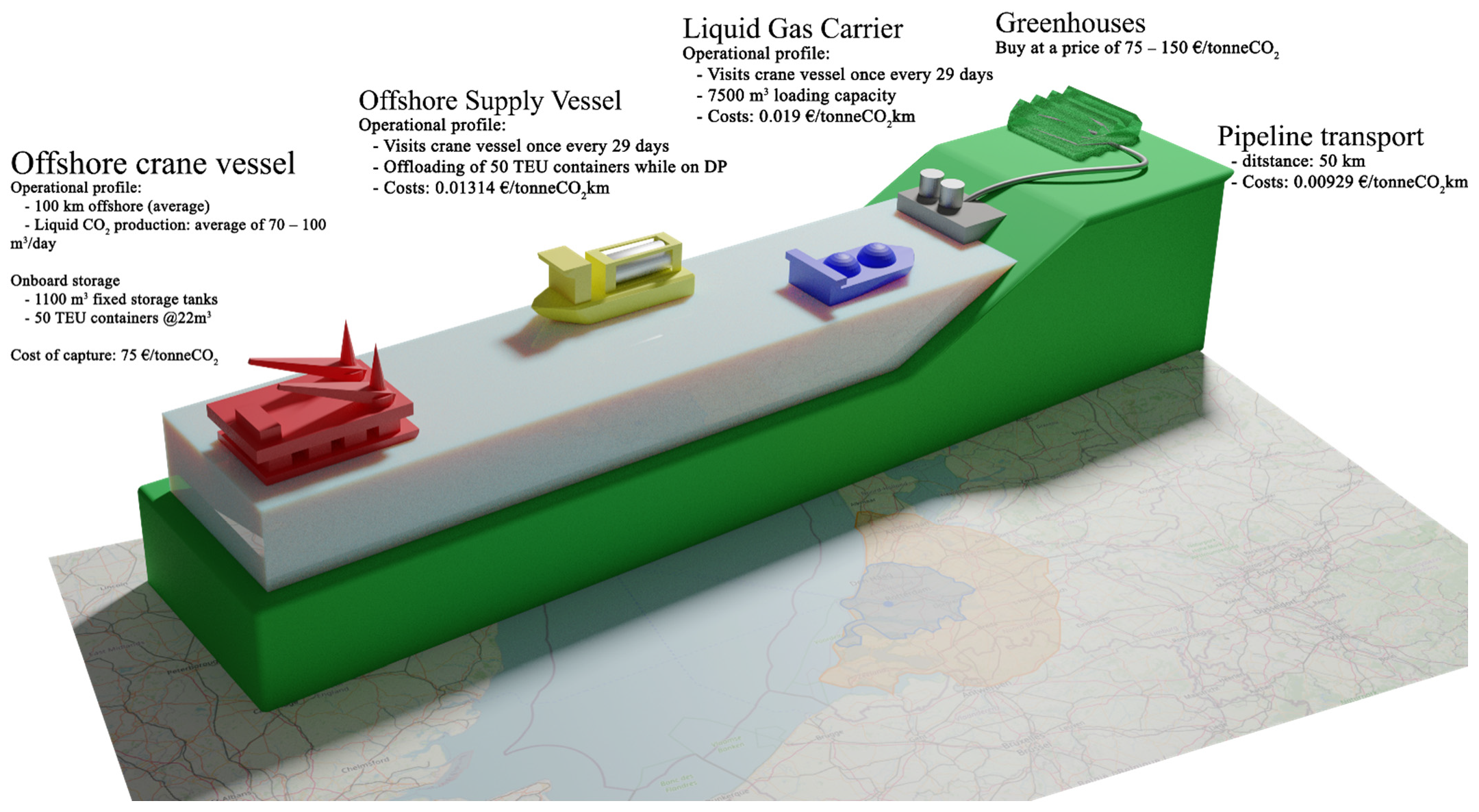
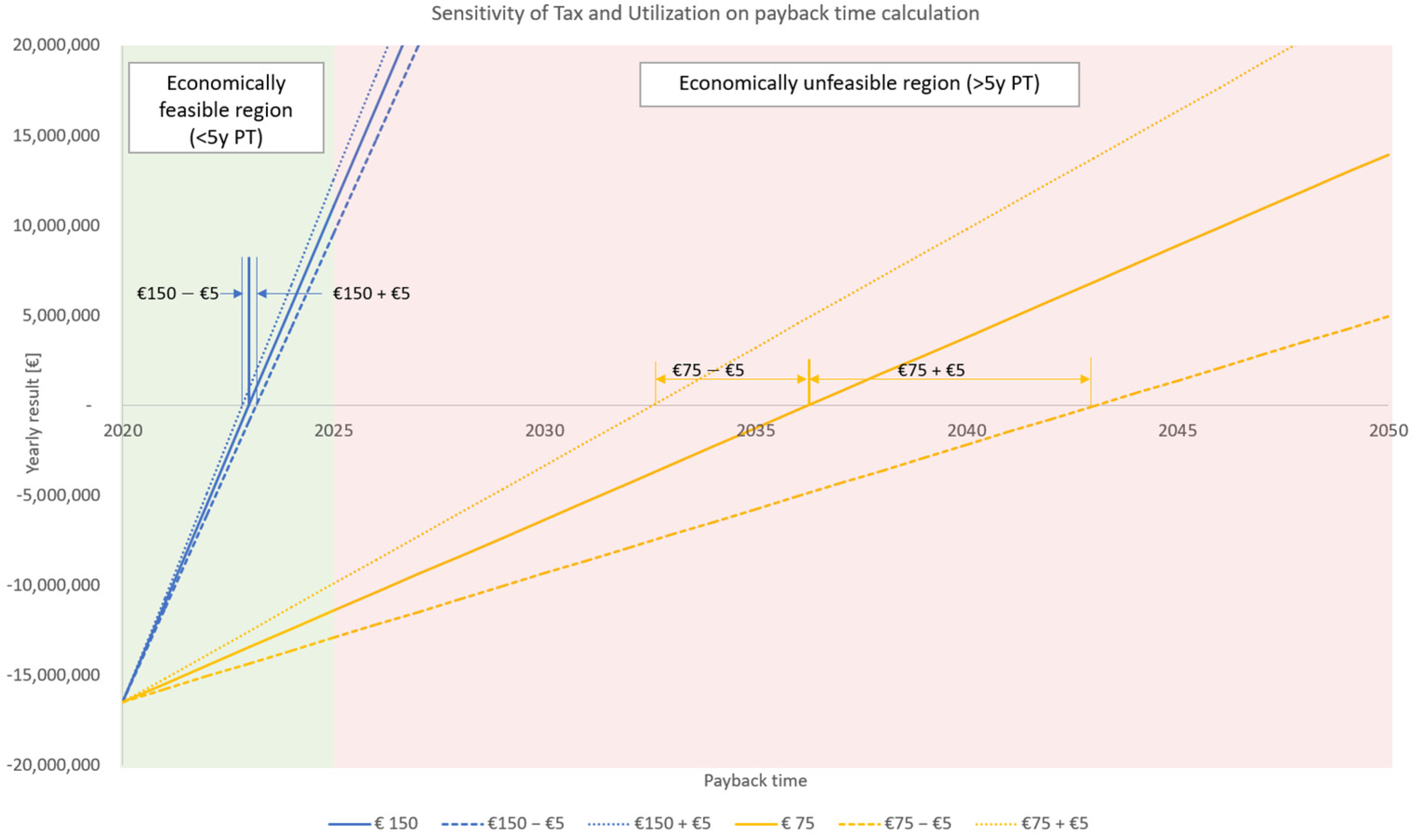
| TRL | Sa | Co | Sc | Av | |
|---|---|---|---|---|---|
| Capture | |||||
| Fixed tanks independent | 9 | 2 | 1 | 1 | 1 |
| Fixed tanks integral | 9 | 3 | 1 | 1 | 1 |
| containers | 9 | 2 | 1 | 1 | 1 |
| Offshore Transportation | |||||
| Liquid gas carriers | 6 | 3 | 2 | 1 | 1 |
| Own vessel | 9 | 2 | 3 | 1 | 3 |
| Offshore supply vessel | 9 | 3 | 2 | 2 | 2 |
| Storage barge | 6 | 3 | 2 | 1 | 1 |
| Onshore Transportation | |||||
| Pipeline | 9 | 3 | 3 | 2 | 2 |
| Road | 9 | 2 | 2 | 3 | 3 |
| Rail | 9 | 2 | 2 | 2 | 3 |
| Inland waterway | 9 | 3 | 3 | 1 | 1 |
| Utilization | |||||
| Materials: solvents/pharmaceuticals/fertilizer/urea | 9 | 3 | 3 | 2 | 2 |
| Direct: Dry ice, beverages, fire extinguishers | 9 | 3 | 3 | 2 | 2 |
| Horticulture | 9 | 3 | 3 | 2 | 2 |
| Sequestration onshore | 9 | 1 | 3 | 1 | 1 |
| Sequestration offshore | 9 | 3 | 3 | 1 | 1 |
| Operational Mode | CO2 [tonne/day] | CO2 [m3/day] |
|---|---|---|
| Working | 80 | 72.66 |
| Sailing | 110 | 99.91 |
| Idle | 27 | 24.52 |
| Port | 35 | 31.79 |
| Effect on Payback Time of: | Min | Max |
|---|---|---|
| Onboard storage × 2 | −20% | −65% |
| Offshore distance × 2 for COC €100 | +25% | +130% |
| Offshore distance × 2 for COC €75 | +60% | +75% |
| Cost of Capture −25% | −17% | −60% |
| Onshore distance × 2 | 0% | +14% |
| Results of Full Case Study (1 Year) | Value | Unit |
|---|---|---|
| Total distance traveled by OSV/LGC | 2517 | Km |
| Total distance traveled via pipeline | 629 | Km |
| Total amount of CO2 emitted by supply chain | 6884 | tonne |
| Total amount of CO2 saved with respect to business as usual | 29,200 | tonne |
| Costs for shipowner without carbon capture | 5,407,000 | € |
| Cost of supply chain per year | 655,121 | € |
| Total profit per year | 4,753,000 | € |
Publisher’s Note: MDPI stays neutral with regard to jurisdictional claims in published maps and institutional affiliations. |
© 2022 by the authors. Licensee MDPI, Basel, Switzerland. This article is an open access article distributed under the terms and conditions of the Creative Commons Attribution (CC BY) license (https://creativecommons.org/licenses/by/4.0/).
Share and Cite
Buirma, M.; Vleugel, J.; Pruyn, J.; Doedée, V.; Schott, D. Ship-Based Carbon Capture and Storage: A Supply Chain Feasibility Study. Energies 2022, 15, 813. https://doi.org/10.3390/en15030813
Buirma M, Vleugel J, Pruyn J, Doedée V, Schott D. Ship-Based Carbon Capture and Storage: A Supply Chain Feasibility Study. Energies. 2022; 15(3):813. https://doi.org/10.3390/en15030813
Chicago/Turabian StyleBuirma, Max, Jaap Vleugel, Jeroen Pruyn, Vincent Doedée, and Dingena Schott. 2022. "Ship-Based Carbon Capture and Storage: A Supply Chain Feasibility Study" Energies 15, no. 3: 813. https://doi.org/10.3390/en15030813
APA StyleBuirma, M., Vleugel, J., Pruyn, J., Doedée, V., & Schott, D. (2022). Ship-Based Carbon Capture and Storage: A Supply Chain Feasibility Study. Energies, 15(3), 813. https://doi.org/10.3390/en15030813






